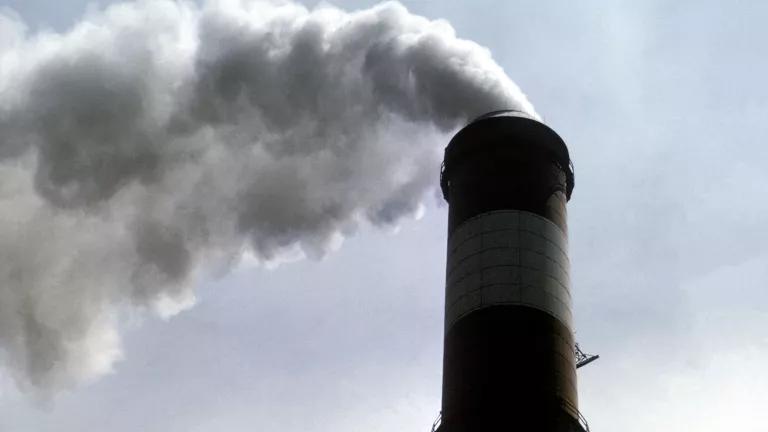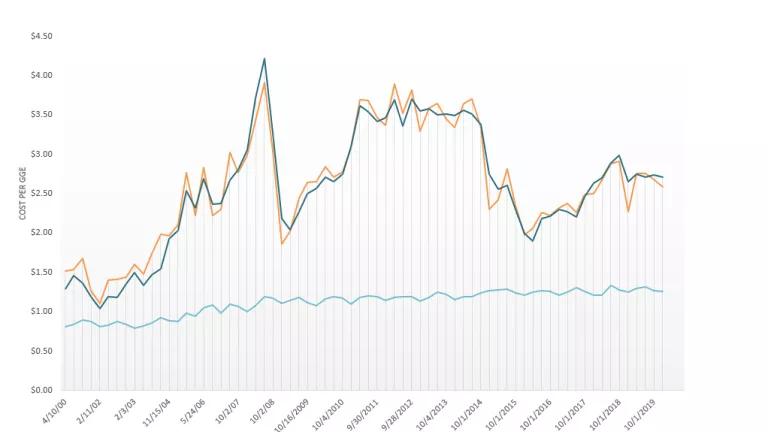FirstEnergy Attempts An Illegal Power Plant Bailout Scheme

Increasingly desperate to keep its failing coal and nuclear plants afloat, FirstEnergy just asked the U.S. Department of Energy (DOE) to issue an emergency order that would cost consumers billions of dollars to keep the plants running in the misplaced name of grid “resilience.” It’s at least the third time FirstEnergy has gone to the well for a profit guarantee. FirstEnergy upped the stakes this time by asking DOE to apply the order to dozens of other coal and nuclear power plants in the large PJM grid region, arguing the risk that these plants might close constitutes a national grid emergency.
But the facts belie the claim. Rather, it will be the millions of utility customers in Delaware, Illinois, Indiana, Kentucky, Maryland, Michigan, New Jersey, North Carolina, Ohio, Pennsylvania, Tennessee, Virginia, West Virginia, and the District of Columbia who will pay the price for this scheme to boost FirstEnergy’s bottom line.
FirstEnergy’s illegal plan is even more audacious because grid operator PJM, federal grid regulators, Ohio, and even DOE have all rejected FirstEnergy’s pleas in the past for the obvious reason: FirstEnergy’s “sky is falling” refrain is just a cover for the company’s bad business decisions. PJM is becoming increasingly exasperated with FirstEnergy’s demands, saying that “nothing we have seen suggests there is any kind of emergency from these units retiring,” calling the problem “fundamentally a corporate issue.”
FirstEnergy’s unorthodox request pits the company against other power generators. It would upend energy markets and—ironically—even undermine reliability by subsidizing hundreds of the oldest power plants on the system while creating new obstacles to integrating cleaner and less risky renewable energy resources.
DOE Secretary Rick Perry should reject FirstEnergy’s request out of hand as without any basis in fact or law. There is no current or future grid emergency, FirstEnergy’s plants aren’t uniquely critical to the grid, and many new resources continue to come on line. (The Sierra Club and joint EDF/NRDC responses to DOE explain why DOE must refuse FirstEnergy’s request.) But Perry is under pressure from Trump to keep coal and nuclear plants running.
FirstEnergy’s troubled plants
FirstEnergy’s power-generating fleet includes five coal and nuclear plants in northern Ohio and western Pennsylvania that are old and costly to run:
The two coal plants are especially poor performers; their output has fallen precipitously over the last seven years:
Declining Output from FirstEnergy’s Coal Plants

Not surprisingly, the grid continues to function reliably even as the two plants operate at much lower output, disproving yet again the myth that coal has unique “baseload” power attributes worth paying for above-and-beyond the value of their energy output.
FirstEnergy’s Fiction
Since it can’t compete against newer and cheaper power plants, FirstEnergy asked DOE to declare that a grid emergency exists, claiming the closure of its plants could leave parts of the nation in darkness from lack of power.
FirstEnergy’s request is both extreme and a work of fiction. The law that it wants DOE to use to declare a grid emergency, Section 202(c) of the Federal Power Act, is reserved for specific, imminent threats during time of war and other national emergencies, natural disasters, and other threats. It’s not intended to be used when there’s no actual grid emergency.
As PJM has affirmed, there is no emergency. And FirstEnergy can’t show that grid resilience is at risk, or that its plants or other plants are needed to ensure a stable and resilient electricity supply.
“Resilience” generally refers to the power system's ability to withstand and reduce the magnitude and duration of disruptions caused by events like extreme weather. Resilience is embedded into the core duties of grid operators to maintain a reliable grid minute-to-minute, and year-to-year. Labeling coal and nuclear power as “resilient” simply to justify a premium payment for the basic product (electricity) is false advertising.
It also ignores that most of the threats to the grid occur from distribution system failures (the smaller poles and lines delivering power to our homes). In contrast, fuel supply failures account for a vanishingly small fraction of grid disruptions (0.00007 percent of all interruptions in the last five years).
Also undercutting FirstEnergy’s position is that earlier this week it notified PJM it planned to retire its three nuclear plants in 2020 and 2021. That hardly constitutes an imminent emergency deserving of a 202(c) order. FirstEnergy’s notice triggers a 90-day PJM review period to assess whether closing the plants will cause any grid reliability issues. If PJM does find a reliability issue (its statements to date suggest that it will not), it may seek to keep one or more of the plants online until a permanent solution allows the plant to retire (such as new transmission, more efficiency). But the last thing PJM wants to do is to pay FirstEnergy to keep its plants running indefinitely, which is precisely FirstEnergy’s goal.
Why we should be worried about DOE
We can’t assume that DOE will again deny FirstEnergy’s plea. Why? First, because last fall DOE proposed an ill-conceived coal/nuclear bailout plan that looked a lot like what FirstEnergy is now asking DOE to do: subsidize coal and nuclear plants for fictional “resilience” benefits. The Federal Energy Regulatory Commission (FERC), which regulates the power grid, unanimously denied DOE’s plan in January, finding that it was unlawful and without any basis in fact. FirstEnergy’s new plan is illegal for precisely the same reasons.
Second, FirstEnergy’s request relies heavily on a very recent and highly flawed DOE National Energy Technology Lab (NETL) study purporting to show the resilience value of coal, oil, and nuclear power plants during this winter’s “bomb cyclone” cold spell in the Northeast. NETL is part of DOE, and it performs research and development on coal, oil, and gas for energy use. One could conclude that through the NETL report, DOE is attempting to create some of the analytical justification that FERC found wanting in its January rejection of DOE’s grid bailout plan. That is not good news.
The NETL report is bad science
The NETL report is rife with flaws. Its basic conclusion is that coal and nuclear plants have unique “resilience” values. NETL’s “proof” is that nuclear, coal, and even oil-fueled plants ran much more than normal during the bomb cyclone cold snap. But all this shows is that these plants were sidelined before the bomb cyclone because they were too expensive. During the storm, the grid needed all available resources to meet high customer demand, hence the increased utilization rate.
By NETL’s flawed metric, the more cost-effective plants that were already running prior to the storm are less “resilient” even where they were more reliable for the system. Running the costlier plants more than normal doesn’t make them more resilient, it just makes them more expensive. The right way to measure reliability, ignored by NETL but frequently used by grid operators, is to look at the failure rate of the plants not only during the storm, but also during high demand events more generally. As Grid Strategies’ Michael Goggin explains, by that metric, coal did not perform especially well. The bottom line is that coal generators were no more reliable during the bomb cyclone than other resources.
PJM has plenty of reliable power
FirstEnergy’s plants are a small portion of the total power fleet in PJM. There are dozens of power plants in Ohio, Pennsylvania, and elsewhere in the region to serve customers, more are under development, and many are cheaper to run than FirstEnergy’s plants.
To put a finer point on it: When FirstEnergy claims that PJM’s energy market sends “distorted” price signals that undervalue the grid reliability and resilience benefits of “traditional baseload resources” like coal and nuclear power, what it is really saying is that prices are too low for it to make money. But that’s because the PJM market is oversupplied. Its 2018 reserve margin (excess power) is 29.1 percent, which nearly twice its target reserve margin of 16.1 percent. That’s far more than necessary for grid reliability. Economics 101 says that the way for markets to correct the “low prices” is for excess inefficient capacity to retire (like the FirstEnergy plants). The answer must not be to pay the plants to avert a non-existent grid emergency.
What about nuclear power and carbon?
It’s up to Ohio, Pennsylvania, or federal legislators to decide whether and how to value the carbon benefit of FirstEnergy's nuclear plants, taking into account nuclear power's costs and other problems, and more affordable and truly clean solutions. Any ends-justify-the-means approach from nuclear advocates defending FirstEnergy’s actions will ultimately spell climate peril. If a precedent were to be set for valuing non-existent “baseload” resilience, that precedent would be used to prop up highly polluting coal plants, stalling climate progress, and providing for the continued emission of other pollutants like sulfur dioxide and nitrogen oxides that contribute to asthma and other health problems plaguing communities across the country.
The grid can run reliably on wind and solar power
Just this week, an official in charge of reliability assessment at the North American Electric Reliability Corporation was quoted in S&P Global Market Intelligence (behind paywall) as saying that the power grid can run well no matter what fuels are on the system. His message basically was:
- The grid can run reliably on 30 percent, 40 percent, even 80 percent renewable resources, so long as you plan and operate the system correctly.
- The grid can accommodate any type of fuel (including fuel-free resources), but policy and structural changes would help.
- No matter the fuel mix, technology and fuel-neutral reliability standards are essential to maintaining grid reliability.
Message to DOE: just say no
FirstEnergy is incapable of lying in the bed it helped make. It supported electricity market competition in Ohio, joined the PJM power market in search of higher prices, fought clean energy programs in Ohio, and held onto its expensive power plants. Justifying billions of dollars in long-term consumer-financed subsidies for the illusory resilience benefits of FirstEnergy’s aging power fleet flies in the face of the facts, discredits the work of grid engineers and others, and will delay clean energy progress. DOE needs to quickly reject FirstEnergy’s misguided scheme.




